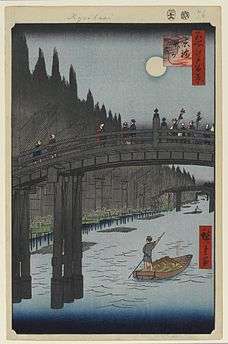Kyōbashi
Kyōbashi (京橋) is the name of a bridge as well as the geographical region around it. Two regions with this name exist in Japan, one is in Tokyo and one lies in Osaka. It refers to a bridge connecting roads to Kyoto.


Tokyo
Kyōbashi is a neighborhood east of Tokyo Station in Chūō, Tokyo, Japan. It is one of the city's oldest commercial districts, although it has since been eclipsed by Ginza to the south and Nihonbashi to the north. Kyōbashi and Takarachō stations provide subway service. Its name comes from the bridge that once spanned the Kyōbashi Canal. The south side of the canal was called Take-Gashi(Bamboo Quay)because it was bamboo wholesalers' area.
The Kyōbashi, or Capital Bridge, linked the Ginza and the Kyōbashi neighborhood. According to the sign erected at the site by the Chuo-ku Board of Education, together with Nihonbashi, it was one of the famous bridges of Edo. When the canal was filled in 1959, the bridge was removed. Today, a pillar stands to mark the site of the old bridge.
Kyobashi was also a ward of Tokyo City, encompassing 16 neighborhoods, including Ginza, Tsukiji, and Tsukishima, in addition to Kyobashi itself. In 1947, when the 35 wards of Tokyo were reorganized into 23, it was merged with Nihonbashi to form the modern Chuo ward.
Kyobashi, together with Nihonbashi and Kanda, is the core of Shitamachi[1], the original downtown center of Edo-Tokyo, before the rise of newer secondary centers such as Shinjuku and Shibuya.
Meidi-Ya, an upscale grocery store chain, has its headquarters in this area.[2]
Osaka
Kyōbashi also refers to the commercial district around Kyōbashi Station in Jōtō-ku and Miyakojima-ku, Osaka. It is located to the north of Osaka Castle. The Kyōbashi area is named after the Kyōbashi bridge. The term "Kyobashi" means "capital bridge", named as it was because the bridge originally led to Kyoto, the capital of Japan during that time. Today there are many izakayas, shot bars and love hotels in the area.
References
- Kokushi Daijiten Iinkai. Kokushi Daijiten (in Japanese). Vol. 4, page 842 (1983 ed.).
- "Company Profile." Meidi-Ya. Retrieved on May 13, 2013. "Head Office 2-2-8 Kyobashi, Chuo-ku Tokyo 104-8302"